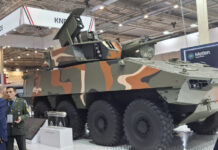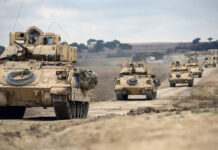It’s tempting to look at the Army’s cancellation of the solicitation for a next-generation troop carrier and conclude that the service has lost its way in figuring out how to meet future combat needs. After all, this is the same service that spent a decade developing a successor to its Kiowa armed reconnaissance helicopter, killed it, and then killed the successor to the successor two years later. End result: Kiowa keeps flying for the foreseeable future. It is also the same service that spent $18 billion developing a net-centric family of future fighting vehicles — the “future combat system” — and then couldn’t convince defense secretary Robert Gates the program made sense. Such episodes don’t inspire confidence.
But most of what has gone wrong with Army modernization plans during the first decade of the new millennium can be traced to the fact that senior policymakers were pushing a concept of future warfare bearing little resemblance to the combat operations soldiers were actually conducting. When your civilian superiors are enchanted with capability-based, network-centric, transformational warfighting concepts but your force is straining to meet the challenge posed by lightly armed and elusive insurgents, it’s pretty hard to come up with a modernization plan that everybody likes. Secretary Gates changed all that by telling Army leaders to forget the fancy theories and focus on winning today’s fight.
So the Army’s revised plan for modernizing its armored vehicles is more practical than visionary, a focused effort to reconcile what is needed with what is affordable. The only new system in the plan is a “ground combat vehicle” that can be fielded in a few years while correcting deficiencies of existing vehicles noted in overseas conflicts. The reason the service pulled back its request for proposals last month was because it feared contractors had been asked to include too many features — a problem that could delay fielding while raising costs. The service is taking two more months to scrub its requirements before going forward. The other parts of the plan are mainly about upgrading existing vehicles to provide greater protection, mobility, awareness and firepower to soldiers as they deal with diverse adversaries employing unconventional tactics.
The basic building block of today’s Army is the brigade combat team, which comes in three flavors: heavy units dominated by Abrams tanks and Bradley troop carriers that provide maximum protection but are difficult to deploy quickly; infantry units that are easier to deploy but more lightly protected; and Stryker units organized around a wheeled (as opposed to tracked) combat vehicle that are more deployable than heavy units but more protected than infantry units. Current brigade combat teams thus offer an adaptable mix of protection and mobility that is tailorable to the character of whatever contingencies arise. That is the logical way to organize ground formations in an era of diverse threats.
The problem with the existing armored vehicle fleet is that it wasn’t designed to cope with improvised explosive devices. Efforts to adapt the fleet to the new style of warfare have used up all the space, weight, power and cooling capacity of the vehicles, leaving little margin for further improvement. The revised vehicle plan seeks to “buy back” that margin by upgrading Stryker, Abrams and Bradley while replacing much older M113 troop carriers. The new ground combat vehicle will replace one type of Bradley troop carrier so that a full squad of nine soldiers can ride inside with improved protection and awareness. It’s a reasonable plan, but given past mis-steps, the Army needs to keep its existing vehicles up to date as a hedge against future failures in fielding better equipment.
This analysis originally published by Loren B. Thompson, Ph.D. Lexington Institute




















